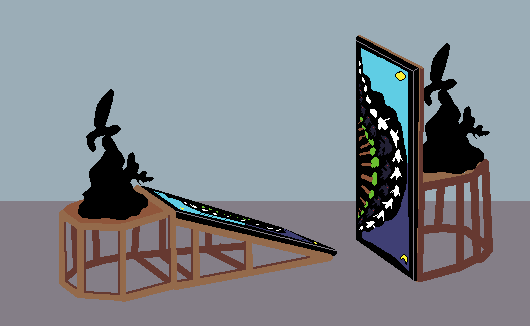 ︎︎︎poster
︎︎︎posterTHIS NOR MUNDANE
- Collective fiction exhibition
17 March 2018 - 14 April 2018
Aaron Grech,
Asst. Prf. Suchanee Glinslisdhi,
Marcel Breuer,
Tammarat Kittiwatanokun,
Beninside,
Bloody Hell Big Head,
Boonyathorn,
gotuya,
Jeff Gompertz,
Jame Jame,
Jub,
Jeno Kim,
MM Kosum,
Nut Sawasdee,
Pearamon Tulavardhana,
Poom Nuthong,
Tae Parvit, Unchalee Anantawat
––––––––––––––––––––––––––––––––––––––
“This nor Mundane” translated directly would mean “Not here nor this world” in which Mundane can be translated as worldly, or daily life. This phrase is grammatically incorrect.
Therefore using this phrase in everyday life would be very confusing. If someone were to say this phrase, it would be a character in a fiction world, where this character had travelled into the fiction within that fiction. Because we often see the existence of the realm within another realm, or even tales, which are fictions of that world that the character in that fiction has invented, for example, the world behind the rabbit hole from Alice in Wonderland, Emerald Dream from World of Warcraft, or the many dimension in many timeline from Rick and Morty.
In the scope of anthropologist, learning culture through cartoon and fictional media is beneficial to understanding of the root of cultural mechanism. Moreover, the industry of creating fictional world is no longer limited only to mainstream media. However, it has been pushed forward by normal people or fan clubs of that fiction. Thus, increasing the number of fictional world, as well as expanding the limit of it. For example, writing a fanfic of a fiction will create another dimension or even another world to the initial fiction, creating new characters, new timeline that expand further than the original fiction. The existence of these new worlds, creates new dimension of visual that goes beyond what we see in our daily life, or even in the world.
In this exhibition, we would like to explore into the procedure of opening these new worlds of each artists. How did the same character that yelled ‘this nor mundane’ traverse out of its original realm. What are the doors between each dimension in different fiction. We could observe that warping or travelling from one galaxy to another galaxy in Startrek and Star Wars have a huge difference in visual. Even traversing from one world to another world is as easy as opening a pink door in Doraemon. These three fictions all have different aspect of visualizing the two realms within it. Therefore, the event that connects realms together has many possibilities. For example, which color does the light create from the book that the character picked out? Or how do the 18 folds of doors look like? Or are there glitches like in post-internet art? All of these are created from the imagination of the creator of that fiction, or for this exhibition, it is the artist themselves.
Therefore, the work of each artist will have different physical space of a fiction. Each physical space will have a door within it, whereas that door maybe the dreamscape of another character in another fiction. This collective fiction exhibition brings fiction creators together to create a dialogue that parallel spaces are present to the audience.
writing by: Pearamon Tulavardhana


︎︎︎exibhition view































